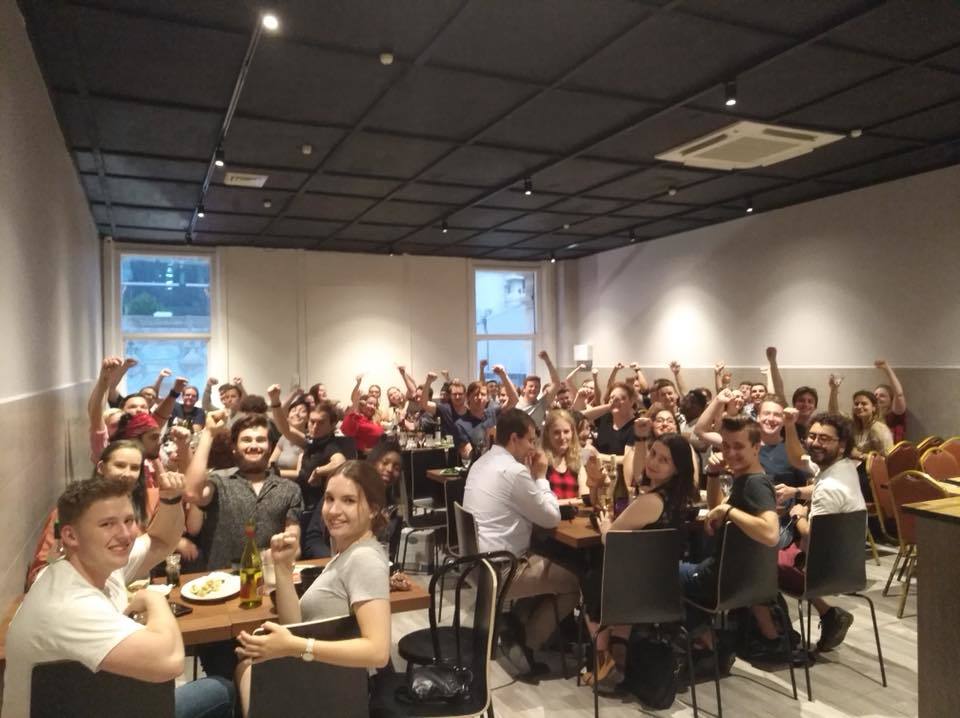



Keep this story going! Share below!
The innovation of Shanghai Village (SuHang) is to increase business scale, which was completed at the end of last year under the leadership of the new owner, Andy, and the manager, Sandy. It cost nearly one month to redecorate the floor and repaint the walls with five people working, and one week of cleaning and filling with tables and chairs. There is also new tableware designed for the new floor to be used. “In overall, Shanghai Village is going to be providing better service and a more comfortable environment for customers,” Sandy said. “We also want more and more people to have a taste of our dumplings since they are really nice and cheap!”
The new floor of the restaurant was a storage room for sundries before being decorated in a modern style and serving more customers. It can contain around 100 people at most, and all tables and chairs are movable to be recombined, so it is flexible for different numbers of groups. What’s more, there are two more toilets in the new floor, which is more convenient for customers.

There were two main reasons for this innovation: one is that the demand of customers exceeded the supply, and the other is that the business had resources that could be reused to increase profits. From Sandy, the manager of the business, we knew that SuHang was always popular and busy day and night, especially on Friday and Saturday nights. The waiting queue could be 5 meters long, and the average wait time was 15–20 minutes. It also caused jas when customers were not in a straight line. In order to alleviate this situation, SuHang needed to expand its business to contain more people at dinner time. The new owner decided to renovate the top floor to reuse it instead of leaving it covered in dust. Therefore, a new floor appeared in December 2018 to increase the capacity by 100 people.
Overall, the innovation of increasing the scale of the business could bring both positive and negative impacts to the business. Positive impacts include meeting the needs of customers, reducing wait times in peak periods, reusing extra space, increasing income, and expanding the company's reputation. However, negative impacts could include overload of work to current staff, risk of more destroyers, food waste, etc.
The innovation also affects other groups. Customers have one more option for dinner, competitors who have small spaces will need to come up with more innovations to gain profits and customers, and unemployed people have new opportunities to be employed. The suppliers of SuHang are also influenced positively because they can sell more products. Sandy said that this innovation does work and meets their expectations. Also, the expansion of business process will be continuing in the future through lengthening working hours.
The straightforward benefit for the restaurant is making more money, as they can sell more food and beverages. Also, SuHang can accept larger group bookings (at most 100 people), which becomes another of its competitive advantages besides its cheap and safe food, full license, and central location in the city. What is more, this innovation benefits the restaurant’s reputation, as customers come from different areas and a wide range of ages. When people want to celebrate a big party for their family, business, or other organizations, Shanghai Village is usually one of the best choices in Melbourne.
As this innovation is an expansion of the business, it is not only a good chance but also a key step in improving its business reputation. Hence, SuHang must ensure the safety of food and sanitation. Moreover, the business focuses more on reducing the waste of food and drinks. It helps SuHang to achieve Goal 11 – Sustainable Cities and Communities as it aligns with Target 11.6 – "By 2030, reduce the adverse per capita environmental impact of cities, including by paying special attention to air quality and municipal and other waste management." Reusing the idle spaces helps SuHang to achieve Goal 12 – Responsible Consumption and Production by meeting Target 12.5 – "By 2030, substantially reduce waste generation through prevention, reduction, recycling and reuse."
In addition, the expansion of business requires a larger staff. SuHang accepts workers no matter whether they have a student visa or work visa as long as they meet the employment criteria. In other words, SuHang is glad to give opportunities to youth. So, the innovation can also help the business to achieve Goal 8 as it promotes the business to provide more employment opportunities for young people and make sure those young people are equally paid for work of equal value.
Get stories of positive business innovations from around the world delivered right to your inbox.
Sandy Li, Manager

Shanghai Village (SuHang) is a Chinese restaurant located in Chinatown in Melbourne. It started running a business in 1998 that has continued until now, with a good reputation and popular for its great tastes and cheap prices. The new owner of Shanghai Village is the son of the original owner, so it is a family business. There are 20 staff members, and most of them are international students who work part time. Even though SuHang sells food in the Chinese style, 90% of its customers are local people, so it could be a kind of cultural conversation and exchange. SuHang is a restaurant with a diverse culture; not only are their customers from different places, but also their employees are from countries other than China, like Malaysia and Cambodia.